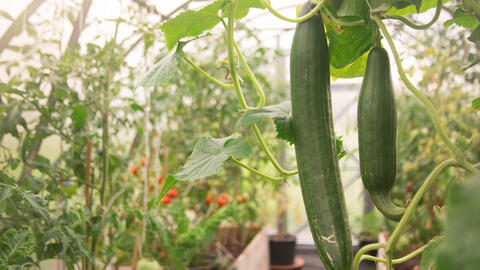Growing cucumbers in a greenhouse: 5 expert tips
Growing cucumbers in the greenhouse is not difficult – you just need to pick the right species and varieties, and care for the plants accordingly. We reveal five expert tips that will ensure a rich harvest.

Salad cucumbers are suitable for greenhouses
Cultivating cucumbers in a greenhouse is different to growing them outdoors. We’ve compiled five expert tips, covering the most important aspects of cultivating cucumbers in the greenhouse: from selecting and sowing the plants to care and growth.
If you want to grow cucumbers (Cucumis sativus) in a greenhouse, you should opt for salad cucumbers. With their smooth skin, they are specially developed for cultivation in greenhouses. Salad cucumbers generally only form female plants and are self-pollinating. Stores offer varieties that are resistant to diseases like leaf spot and have a high resistance to powdery mildew. Young plants that have been grafted on pumpkin plants are equally robust and ideal for greenhouses.
You can sow cucumbers in heated greenhouses from March/April, but in unheated greenhouses you should wait until May. The seeds need evenly moist soil and a constant temperature of 68 degrees to germinate. As soon as the first seed leaves (cotyledons) appear, you can remove the weaker young plants, leaving only the strongest cucumber plants. When they are between 8 and 12 inches tall, they can be put in their final location in the greenhouse with a distance of around two feet between each plant. Grafted cucumbers should be planted so that the grafting site is a finger’s width above the soil. Since cucumbers prefer nutrient and humus-rich soils, it is important to enrich the soil with mature compost before planting. Cucumbers can also be planted in large tubs. Lightly earthing up cucumber plants promotes the development of adventitious roots.
Cucumbers are heat-loving plants that need light to thrive. However, if the sunlight is too strong – especially during hot days – the plants should also be provided with some shade in the greenhouse. Putting shade cloth or nets on the glass roof protects the plants from direct sunlight, as do shade-giving neighboring plants like tomatoes.
Cucumbers require plenty of water and need to be well cared for in the greenhouse. It is therefore best to water the root area thoroughly in the morning, and with lukewarm water. In order to avoid fungal diseases, the leaves should be kept dry or be able to dry off well. A layer of mulch ensures that the soil is evenly moist and does not dry out too quickly. When the fruit develops, it can be fertilized weekly with a liquid fertilizer – one cucumber plant needs around one liter of a nutrient solution containing organic liquid fertilizer.
Although it is important for cucumbers to have a relatively high humidity in the greenhouse, they do need a bit of fresh air from time to time. This prevents fungal diseases like downy mildew. Open the doors and windows of the greenhouse regularly in the mornings and evenings to let some cool air in.

Cucumbers should be grown on climbing aids both in open ground and in greenhouses. You can use scaffolds, trellises, or even sturdy string to guide the plants upwards. This keeps the fruit away from the ground, ensuring it is better ventilated and easier to harvest. The string should be tied to the roof structure or a support wire. Spiral the cucumber plants around the stem and wrap the shoots around the string once or twice a week until they reach the holder. Tip: Trimming the side shoots behind the first flower ensures strong plants and plenty of fruit.



